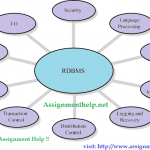Introduction to Database Management Systems

Database introduction by assignment help:
The database management system is also known as the DBMS. It is a system that is developed to organize the data in such a way that it is easy to retrieve that data, easy to insert new data, and also easy to modify the data and also to delete the data. It organizes the data in the tables or the views and follow schema. schema can be defined as a structure in which will be followed while inserting the data into the database.
Like other storage system databases also had some problems like duplication of data so to overcome that challenges DBMS introduced the concept of Normalization.
Normalization is known as the technique in which we reduce the data redundancy and removes various anomalies like insertion, deletion, and update. In normalization, we divide our larger tables into a number of tables and link them with the help of the key. These keys can be a primary key and foreign key.
Level of normalization:
To have a better quality database we should keep our tables to at least In 3NF. In normalization we 4 levels
1NF
2NF
3NF
BCNF
1NF: table is said to be 1NF when there are atomic values for each column attribute.
2NF: table is said to be 2NF when is satisfy two rules that are
- It is in 1NF
- There is a primary key in the table.
The primary key is defined as the key which is defined while the creation of the table. It contains only unique values and it cannot be left NULL.
3NF: table is said to be in 3NF when it satisfies two rules that are
- It is in 2NF.
- And there is no transitive functional dependency.
Transitive functional dependency: it is defined as when a change in a non- key column causes another non-key column to change.
BCNF: it is also known as 3.5 normal form. When there is more than one candidate key it results in anomalies.
Normalization is done in order to help DBMS to develop such a database system that is secure and cost-effective.
The foreign key is used to connect two tables and it references the table with a primary key.
Commands in DMBS are divided into 3 parts:
DML: it is defined as data manipulation language and is used to manipulate the data in the database tables and it contains commands like select, insert, update, delete, merge, call, lock table, explain plan.
DCL: it is defined as data control language and is used to control such operations and it contains commands like revoke, commit.
DDL: it is known as data definition language and is used to define the schema of the table and it contains the commands like create, alter, drop, truncate, comment, rename.
There are many types of software that are used to manage Database examples MySQL, Oracle, SQL, MongoDB, apache HIVE SQLlite.
This software can be used as per the need of the enterprise and the type of data.
We can have two types of data
- Structured data.
- Un-structured data.
Structured data: it is defined as the type of data that is stored in a well-defined manner.
Unstructured data: it is defined as when there is no order for data on how it is being stored.
Are you searching online for a database assignment help experts? Assignment Help is a reliable source for all kinds of assignment help in databases. Order now to avail the best database assignment help services from reliable database experts at affordable prices. We are providing plagiarism free awesome assignment help 24×7 for all kinds of database management assignment help or database homework help. Assignment Help is the one-stop solutions for all database academics courses or online database exams or online quizzes by the top-rated database engineers

